Gram staining - Study guides, Class notes & Summaries
Looking for the best study guides, study notes and summaries about Gram staining? On this page you'll find 1529 study documents about Gram staining.
Page 4 out of 1.529 results
Sort by
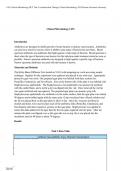
-
2024 BUNDLE FOR Clinical Microbiology WGU C453 (Task 1 Bacterial Morphology and Gram Staining, Task 2 Culturing and Identifying Microbes, Task 3 Antimicrobial Therapy)
- Package deal • 4 items • 2024
-
- $30.49
- + learn more
2024 BUNDLE FOR Clinical Microbiology WGU C453 (Task 1 Bacterial Morphology and Gram Staining, Task 2 Culturing and Identifying Microbes, Task 3 Antimicrobial Therapy)

-
BIO 171 Final Exam (100% correct Answers) | LATEST UPDATE | Portage Learning
- Exam (elaborations) • 20 pages • 2022
-
- $14.49
- 17x sold
- + learn more
Final Exam - Requires Respondus LockDown Browser + Webcam Due No due date Points 120 Questions 30 Time Limit 90 Minutes Requires Respondus LockDown Browser Instructions The Final Exam is compos ed of questions based upon material presented in the entire course. It will assess your level of mastery of the course content and goals. The format of the exam is similar to past module exams. You are about to begin a timed exam. Please make sure you are in a suitable, quiet place, free from distraction....
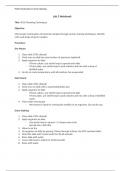
-
BIOD 171 PL03 Introduction to Gram Staining: Mounting techniques (Portage learning) FALL 2023
- Other • 4 pages • 2023
-
Available in package deal
-
- $18.49
- + learn more
Title: PL03 Mounting Techniques Objective: Microscopic examination of bacterial samples through various staining techniques. Identify color and shape of given samples. Procedure: Dry Mount 1. Clean slide (70% ethanol) 2. Circle area on slide for easy location of specimen (optional) 3. Apply organism to slide: - If from culture, use sterile loop to spread onto slide - If from plate, use sterile loop to pick colonies and mix with a drop of distilled water 4. Air dry at room temperature...
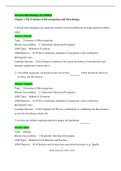
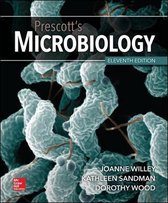
-
Test Bank For Prescotts Microbiology 11th Edition By Willey Chapter 1-43 |Complete Guide A+
- Exam (elaborations) • 1422 pages • 2023
-
- $17.99
- 5x sold
- + learn more
Prescott's Microbiology, 11e (Willey) Chapter 1 The Evolution of Microorganisms and Microbiology 1) Extant microorganisms are organisms from the fossil record that are no longer present on Earth today. Answer: FALSE Topic: Taxonomy of Microorganisms Bloom's/Accessibility: 2. Understand / Keyboard Navigation ASM Topic: Module 01 Evolution ASM Objective: 01.05 The evolutionary relatedness of organisms is best reflected in phylogenetic trees. Learning Outcome: 01.02a Propose a timeline of the ori...

-
PATHOLOGY HIGH YIELD NBME ELABORATED QUESTIONS AND REVIEWED ANSWERS 2023/2024
- Exam (elaborations) • 82 pages • 2023
-
Available in package deal
-
- $17.99
- 2x sold
- + learn more
PATHOLOGY HIGH YIELD NBME ELABORATED QUESTIONS AND REVIEWED ANSWERS 2023/2024 Anticentromere antibodies - CORRECT ANSWER-Scleroderma (CREST) Antidesmoglein (epithelial) antibodies - CORRECT ANSWER-Pemphigus vulgaris (blistering) Anti-glomerular basement membrane antibodies - CORRECT ANSWER-Goodpasture's syndrome (glomerulonehpritis and hemoptysis) Antihistone antibodies - CORRECT ANSWER-Drug-induced SLE (hydralazine, isoniazid, phenytoin, procainamide) Anti-IgG antibodies - CORRE...

-
Lesson 5 - Infectious Diseases (Bacteria)
- Exam (elaborations) • 15 pages • 2024
-
- $7.99
- + learn more
gram staining uses a ____ soluble dye called ___ ____ to stain the ___ ___ - ANSWER-water; crystal violet; cell wall positive gram staining color - ANSWER-purple (dye sticks to thick peptidoglycan cell wall) negative gram staining color - ANSWER-pink (counter stain of safranin or fuchsine) gram + bacteria have cell walls made of - ANSWER-polysaccharides and charged AAs in peptidoglycan wall gram + bacteria can resist ___ in intestines but can be digested by ____ - ANSWER-bile; lysozymes ...
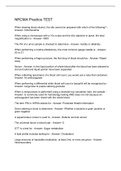
-
NRCMA Practice TEST Questions And Answers
- Exam (elaborations) • 12 pages • 2023
-
- $13.59
- 1x sold
- + learn more
When drawing blood alcohol, the site cannot be prepared with which of the following? - Answer- Chlorhexidine When using a microscope with a 10x ocular and the 40x objective in place, the total magnification is - Answer- 400X The PH of a urine sample is checked to determine - Answer- Acidity or alkalinity When performing a routine phlebotomy, the most common gauge needle is - Answer- 20 or 21 When performing a finger puncture, the first drop of blood should be - Answer- Wiped away ...
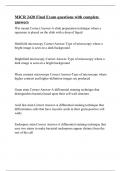
-
MICR 2420 Final Exam questions with complete answers
- Exam (elaborations) • 20 pages • 2024
-
- $14.49
- + learn more
Wet mount Correct Answer-A slide preparation technique where a specimen is placed on the slide with a drop of liquid Darkfield microscopy Correct Answer-Type of microscopy where a bright image is seen on a dark background Brightfield microscopy Correct Answer-Type of microscopy where a dark image is seen on a bright background Phase contrast microscopy Correct Answer-Type of microscopy where higher contrast and higher-definition images are produced Gram stain Correct Answer-A differe...
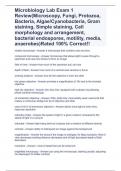
-
Microbiology Lab Exam 1 Review(Microscopy, Fungi, Protozoa, Bacteria, Algae/Cyanobacteria, Gram staining, Simple staining, Cell morphology and arrangement, bacterial endospores, motility, media, anaerobes)Rated 100% Correct!!
- Exam (elaborations) • 9 pages • 2023
-
Available in package deal
-
- $12.99
- + learn more
Microbiology Lab Exam 1 Review(Microscopy, Fungi, Protozoa, Bacteria, Algae/Cyanobacteria, Gram staining, Simple staining, Cell morphology and arrangement, bacterial endospores, motility, media, anaerobes)Rated 100% Correct!!
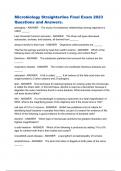
-
Microbiology Straighterline Final Exam 2023 Questions and Answers.
- Exam (elaborations) • 14 pages • 2023
-
- $10.99
- 1x sold
- + learn more
Microbiology Straighterline Final Exam 2023 Questions and Answers. phylogeny - ANSWER The study of evolutionary relationships among organisms is called ______. Last Universal Common Ancestor - ANSWER The three cell types discussed, eukaryotes, archaea, and bacteria, all derived from ______. always harmful to their host - ANSWER Organisms called parasites are ______. Thermal hot springs warmed by heat from earth's interior - ANSWER Which of the following does not indicate microbe involveme...

That summary you just bought made someone very happy. Also get paid weekly? Sell your study resources on Stuvia! Discover all about earning on Stuvia


